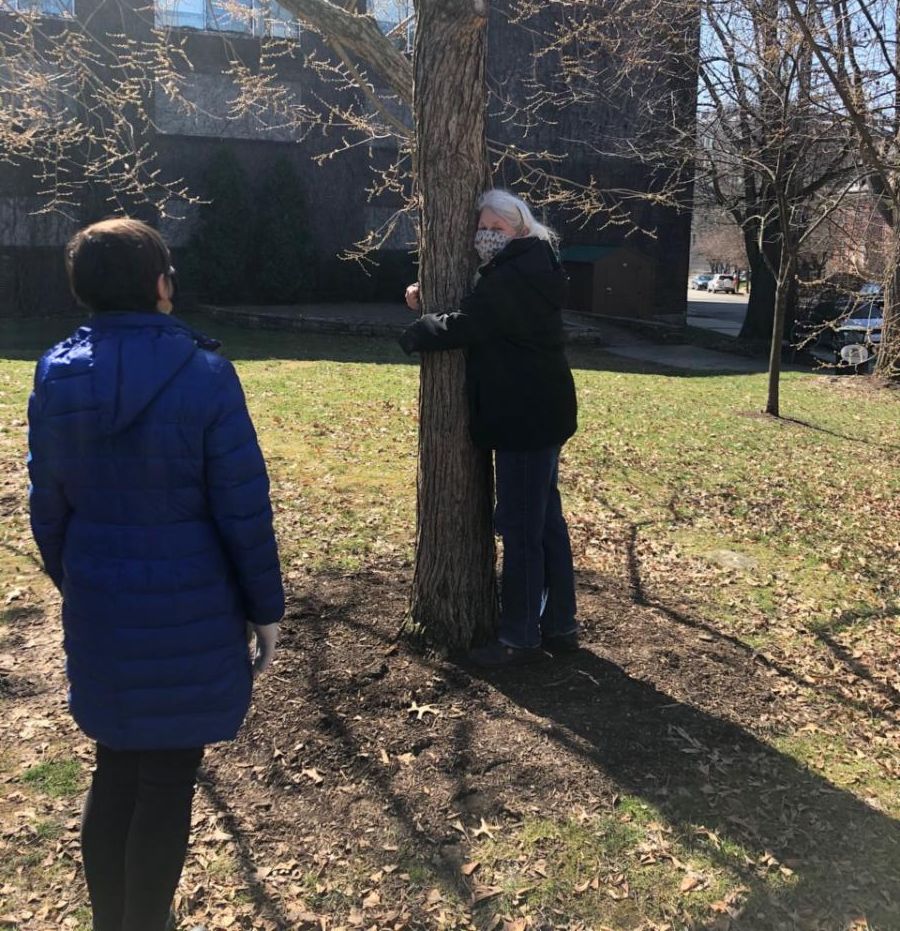
When the pandemic shrunk my world, I took to the nearby forest trails. Unable to fly to a place with more agreeable weather, and unaccustomed to hiking on uneven hilly trails, I got some trekking poles on Amazon, bundled myself up in wooly windbreaking layers against the wintery weather in Western Pennsylvania, and began exploring the local version of the great outdoors.
When I started out last fall many of the trees had turned their fall colors, and the canopy had begun thinning. By early November there were leaves a plenty on the ground to select and bring home to add to the nature art collage on the living room mantel. By mid-November, just a few colorful specimen trees stood out against their barren cousins. December brought episodes of new fallen snow coating the entire landscape, sticking to the trunks and branches and highlighting the trees’ shapes and sculptural forms. Throughout winter there wasn’t a hint of green anywhere. Nothing to distract from the wooden sculptures of the tree trunks and branches–some still standing, others decimated and sprawled out across the uneven ground. Was it always this tough to be a tree or have things gotten worse with the more severe storms, and floods of global warming?
When dealing with multiple losses, the forest is a strong reminder that we are part of the larger web of life. The ecologist, Suzanne Simard, in her book Finding the Mother Tree: Discovering The Wisdom of the Forest writes, “Trees are linked to neighboring trees by an underground network of fungi that resembles the neural networks in the brain.” A Douglas fir, injured by insects sends chemical warning signals to a ponderosa pine growing nearby. The pine tree then produces defense enzymes to protect against the insect. When a tree is dying, and that takes a long time, Simard has documented that 40% of its carbon is transmitted into neighboring trees strengthening the next generation of trees.
Then there is the medicine– Simard spoke on NPR about how having breast cancer caused her to appreciate trees even more. A chemical produced by yew trees for its own defense has become a major chemotherapy drug Taxol, prominent in her own and many other women’s recovery.
In early spring, at the inspiration of musician and vocal teacher, Elizabeth Jett Downing, our non-profit InterPlay Pittsburgh decided to explore playing with trees. We began, (in person, masked and distanced) in a small urban park. We called the improvisational events–Dance with the Trees, InterPlay in the Park. After two rounds our appreciation and connection to trees has grown to the point where this Saturday May 8th at 11 am we’ll be at the White Ash Grove in the larger 126-year-old Riverview Park. Our preparatory visit to the Ash Grove revealed there were no Ash Trees, though plenty of standing dead trees circling the central Oak. After an inquiry to Ranger Nancy we learned there were 2000 ash trees in the park until the invasive Emerald ash bore arrived twenty years ago. The white ribbon around the dozen remaining Ash show that they are being treated and saved.
We protect what we love and I for one, have fallen back in love with the forest and its trees. If you live near Pittsburgh, we’d love to have you join us this weekend. Here’s the link to register.
If you live too far to join us, we recommend you try playing and dancing with some trees in your own neighborhood parks. The trees have much to teach us about our own welfare and the welfare of this planet on which we all depend. Exploring your own local version of the great outdoors will likely result in your taking the necessary actions to protect what you and your children have come to love.

